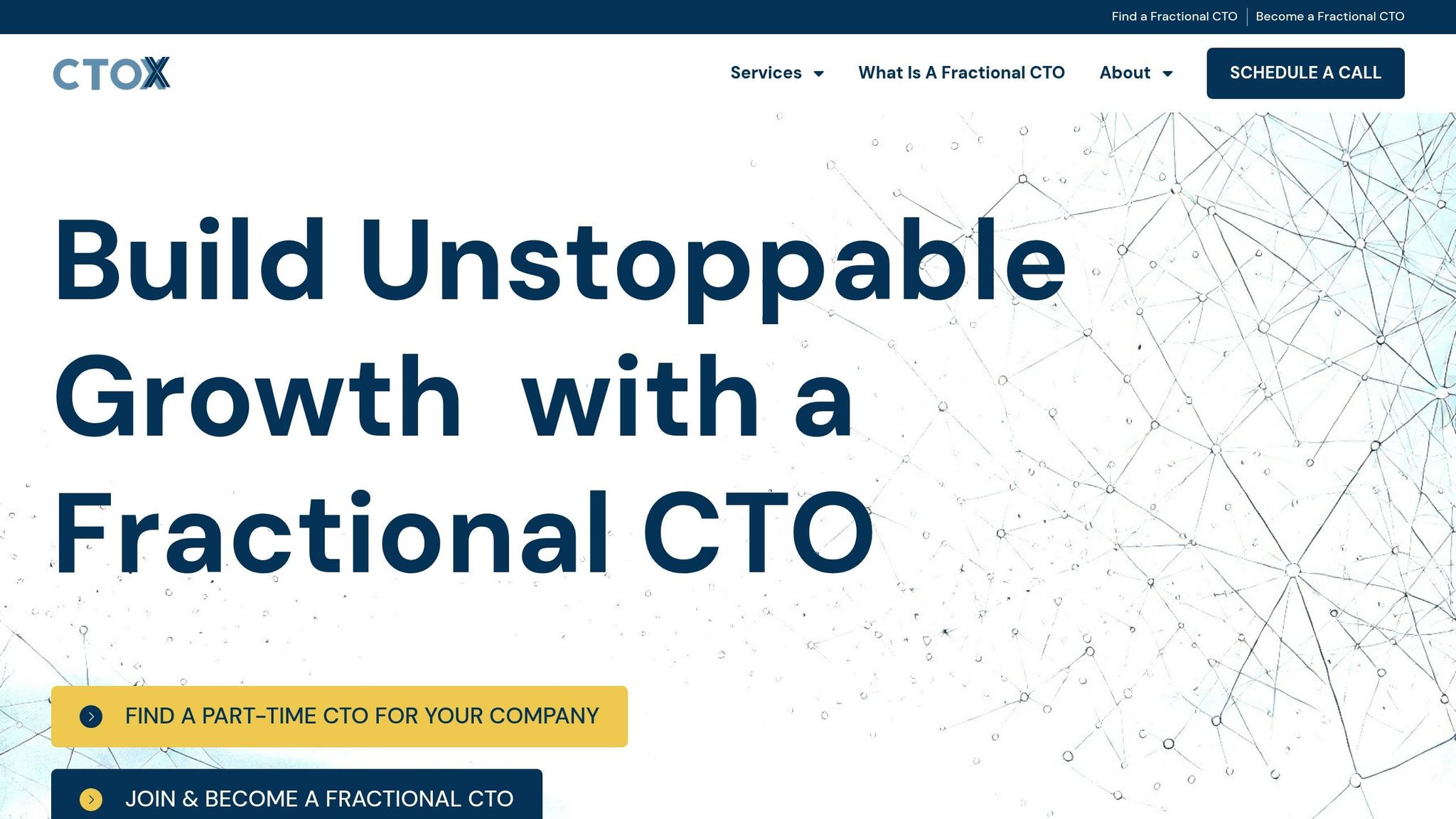Fractional CTOs help businesses save money and achieve better results by offering part-time technology leadership. Here’s how they prove their value:
- Cost Savings: A Fractional CTO costs around $156,000 annually (at $300/hour for 10 hours/week), compared to a full-time CTO’s median salary of $230,495.
- Productivity Boost: They reduce stress on teams and improve efficiency, avoiding productivity drops like the 30% seen in overworked developers.
- Clear ROI Metrics: Focus on measurable goals like cost reduction, revenue growth, and system reliability.
- Financial Impact: Demonstrate cost savings, increased team output, and revenue growth through better tech strategies.
- Non-Financial Benefits: Improve market position, reduce risks, and enhance decision-making with data-driven insights.
Related video from YouTube
Setting Clear ROI Metrics
Tie technology efforts directly to business goals to drive growth and improve efficiency. This approach helps create a clear path to align with client objectives.
Mapping Client Goals
Start by focusing on your clients’ main business priorities. Key areas to address include:
- Cost optimization: Look at reducing infrastructure expenses, operational overhead, and maintenance costs.
- Revenue growth: Focus on improving the sales pipeline, acquiring new customers, and expanding into new markets.
- Efficiency gains: Consider automating processes, boosting team productivity, and making better use of resources.
"Knowing what the CEO and executive team want to achieve and aligning to their expectations is paramount for success." – Michelle Heath, Fractional CMO, Growth Street
During the initial assessment, establish performance benchmarks to track progress:
| Assessment Area | Key Metrics | Timeline |
|---|---|---|
| Technical Infrastructure | System uptime, response times, security incidents | 1-2 weeks |
| Team Performance | Development velocity, bug resolution time, deployment frequency | 2-4 weeks |
| Business Impact | Customer satisfaction scores, revenue per user, market share | Ongoing |
Defining Success Metrics
Create clear KPIs that demonstrate real results. Use the SMART framework: Specific, Measurable, Achievable, Relevant, and Time-bound.
"The salient point here is you measure what you have been chartered to resolve for the client when you arrive, throughout the engagement, and when you depart. We can measure anything we set out to resolve and use it to gauge our progress." – David Rogers, Principal, Coalescence CIO Advisory
For tech investments, focus on metrics tied to business outcomes, such as:
- System Performance: Monitor reliability and speed improvements.
- Team Productivity: Assess development velocity and quality of output.
- Business Growth: Track revenue changes and shifts in market position.
- Risk Reduction: Measure decreases in security incidents and system downtime.
For example, one manufacturer reduced system downtime by 25% after introducing IoT monitoring under their Fractional CTO’s guidance. A mid-sized company cut operational costs by 30% through strategic IT restructuring.
"The most important metric for IT success is rate of change." – Nicolas Avila, CTO for North America at Globant
Schedule regular check-ins to ensure progress aligns with these metrics. This keeps efforts on track and provides a clear way to measure both financial and operational returns.
Measuring Financial Results
Fractional CTOs need to demonstrate their financial impact by tracking metrics that clearly show monetary returns.
Cost Reduction Analysis
Review spending on infrastructure, vendor management, and automation to identify areas where costs can be cut. Track both short-term savings and long-term benefits. Additionally, measure how leadership improves team productivity and efficiency.
Team Output Metrics
After addressing cost reductions, focus on how technology leadership enhances team performance. Use measurable data to highlight the financial impact:
- Development Velocity: Track increases in features delivered per sprint.
- Quality Metrics: Monitor reductions in bugs and technical debt.
- Resource Utilization: Measure how team capacity and workloads are optimized.
By documenting these metrics, you can clearly show how improved workflows and performance tie into revenue growth.
Revenue Impact Tracking
It’s not just about cutting costs – it’s also about driving revenue. Track how technology initiatives directly contribute to revenue growth by focusing on:
- Digital Transformation ROI: Analyze sales growth and customer acquisition through metrics like conversion rates and customer lifetime value.
- Market Expansion Impact: Highlight revenue from new markets, products, or digital services enabled by technology.
- Customer Experience Gains: Measure the financial effects of improved customer retention, higher average order values, and successful cross-selling.
When sharing financial results, connect these metrics to the company’s original goals. Show clear cause-and-effect relationships between technology efforts and financial outcomes. Use historical data and industry benchmarks to give context to your findings.
sbb-itb-4abdf47
Showing Non-Financial Benefits
A Fractional CTO’s value goes beyond just financial returns. They play a key role in influencing areas like market positioning and risk management, which are critical for long-term success. While financial performance is important, these non-financial benefits often set companies apart in competitive industries.
Strengthening Market Position
Fractional CTOs leverage technology to enhance market positioning in several ways:
- Brand Differentiation: Measure shifts in how customers and industry peers perceive the brand through surveys and rankings.
- Digital Presence: Track improvements in online visibility, engagement, and overall digital reach.
- Leadership in Innovation: Document the adoption of cutting-edge technologies that set the company apart.
Here’s a snapshot of key metrics to monitor market impact:
| Metric Category | What to Track | Why It Matters |
|---|---|---|
| Customer Experience | Response times, satisfaction scores | Indicates better service quality |
| Digital Innovation | Adoption of new features, user activity | Demonstrates technological progress |
| Market Reach | Expansion into new regions or markets | Signals growth opportunities and influence |
Enhancing Risk Management
Risk management is another area where Fractional CTOs deliver measurable results. By addressing vulnerabilities and improving stability, they help protect and grow company value. Key areas to focus on include:
- Security Enhancements: Track reductions in incidents and faster response times to threats.
- Compliance Success: Monitor audit completions and adherence to regulations.
- System Reliability: Measure improvements in system uptime and fewer outages.
For example, a healthcare startup implemented HIPAA compliance measures and NIST frameworks under the guidance of a Fractional CTO. This not only safeguarded patient data but also enabled the company to expand into telehealth services.
Driving Decisions with Data
Data analytics is a powerful tool for aligning technology with strategic goals. Fractional CTOs can demonstrate their impact by:
- Evaluating the quality of decisions and forecasting accuracy.
- Highlighting operational improvements driven by data insights.
To make technical data meaningful for business leaders, focus on:
- Linking metrics to the company’s overall goals.
- Presenting trends and patterns in a clear, visual format.
- Offering actionable recommendations based on detailed analysis.
This approach shows how non-financial metrics complement financial outcomes, offering a complete picture of a Fractional CTO’s contributions.
Building Clear ROI Reports
Clear ROI reports turn tracked metrics and outcomes into insights that demonstrate business value. To create effective reports, combine visual clarity, engaging storytelling, and tailored insights.
Data Visualization Tips
Visuals are powerful tools for emphasizing key data, but they should be simple and easy to interpret. Use these tips to create effective charts and graphics:
| Visualization Type | Best Used For | Key Considerations |
|---|---|---|
| Bar/Column Charts | Comparing metrics over periods | Limit categories to 8 for better clarity |
| Line Charts | Showing trends over time | Highlight major trend changes |
| Heat Maps | Identifying high-impact areas | Use clear and intuitive color schemes |
| Interactive Dashboards | Dynamic data exploration | Ensure navigation is straightforward |
Always include clear titles, labels, and annotations to avoid confusion. Stick to consistent color schemes and avoid using too many colors, which can distract from the data. These techniques help visuals support the story you’re telling in your report.
Writing Result Stories
Translate technical achievements into business outcomes. For instance, a Fractional CTO redirected a $1.5M IT budget from outdated systems to cloud solutions, resulting in $200,000 savings and improved performance.
When crafting these stories, follow a structure:
- Start with the business problem.
- Explain the technical solution.
- Highlight measurable results.
- Touch on long-term benefits.
This approach ties the data to real-world impact, making your report more engaging and relatable.
Report Customization
Tailor reports to address the specific needs of your audience.
"Ultimately, good communication is all about perspective-taking. Marketers must take time to understand their audience and report on what they care about. Focus on telling a story – the ‘how’ and ‘why’ – rather than just ‘presenting the facts.’" – Christian Rigg, Head of Operations at Eleven
Focus on 3–5 key metrics, include relevant benchmarks, and provide forward-looking insights. Summarize the findings concisely while emphasizing the ‘how’ and ‘why’ behind the data.
Customized reports like these effectively highlight both financial and operational achievements, giving stakeholders a clear understanding of the Fractional CTO’s contributions.
CTOx ROI Tools and Support
CTOx equips Fractional CTOs with tools and methods to clearly show the value they bring to both tech leaders and businesses. By building on established ROI metrics, CTOx programs focus on delivering measurable financial and operational results.
CTOx Accelerator Training
The CTOx Accelerator program is designed to help tech leaders master the art of tracking and presenting ROI. Through specialized training, participants learn to turn technical achievements into clear business outcomes. Using CTOx’s proprietary Functional Technology™ Framework, Fractional CTOs gain skills such as:
- Turning raw data into actionable insights
- Creating regular KPI scorecards
- Conducting 90-day audits
The program focuses on connecting technical work to business goals. For instance, CTOx coaches teach leaders how to explain the role of technology in identifying customer trends or increasing sales.
While the training sharpens these skills, CTOx’s client matching service ensures they are applied immediately to produce tangible business results.
CTOx Client Matching
CTOx’s client matching service aligns Fractional CTOs with businesses in a way that delivers results from the start. The process is built around key performance indicators (KPIs):
| Component | ROI Focus | Measurement |
|---|---|---|
| Initial Assessment | Technology-Business Alignment | System Audit |
| Ongoing Support | Strategic Guidance | KPI Scorecards |
| Value Tracking | Cost Optimization | Monthly Reports |
The matching process includes:
- Defining clear technology goals before the partnership begins
- Setting up systems to track performance
- Using transparent reporting methods
Regular audits, KPI scorecards, and monthly reports ensure that technology strategies are aligned with business growth. With global digital transformation spending expected to hit $2.5 trillion in 2024, CTOx positions its Fractional CTOs as key partners in maximizing these investments. Research shows that such services can save businesses between $3,000 and $15,000 per month, depending on the scope of the project and the expertise required.
Conclusion
Proving ROI is key for Fractional CTOs to maintain strong client relationships and deliver measurable outcomes. By using a focused, data-driven approach to ROI reporting, tech leaders can clearly connect their efforts to business results. Setting clear goals and tracking the right metrics allows Fractional CTOs to highlight their impact effectively.
"By setting clear objectives, measuring the right metrics, and understanding the breadth of value that a fractional CxO brings, you can confidently assess the ROI of this non-traditional leadership role" – Robert Caputo, Fulcrum
This approach is backed by real-world examples. For instance, one client with a $1.5M annual IT budget saved nearly $200,000 by shifting resources from outdated systems to scalable cloud solutions, all while boosting system performance.
Achieving consistent ROI means prioritizing ongoing measurement and keeping communication open. Successful Fractional CTOs focus on:
- Presenting tech initiatives in terms of clear business benefits
- Defining KPIs that align with what stakeholders care about
- Regularly tracking and sharing performance updates
- Educating teams to strengthen internal expertise
These strategies help Fractional CTOs demonstrate their value over time and support meaningful business improvements. They lay the groundwork for steady growth and continuous impact.








